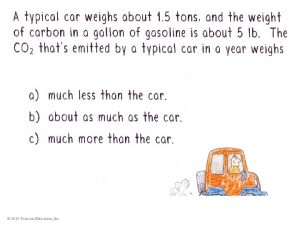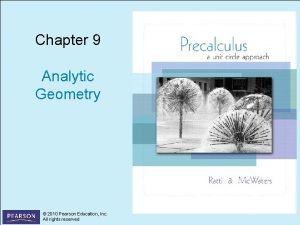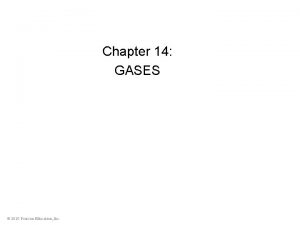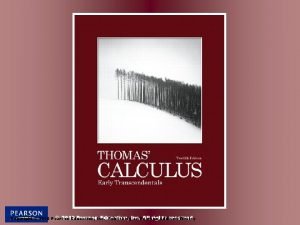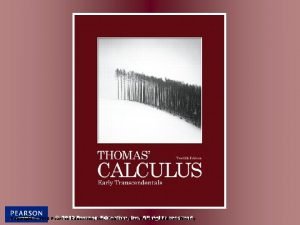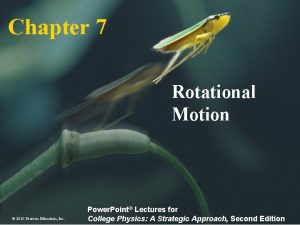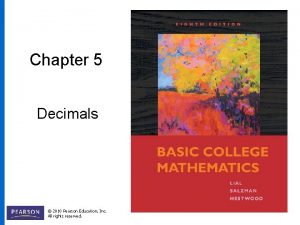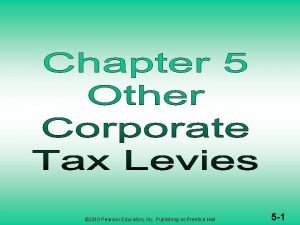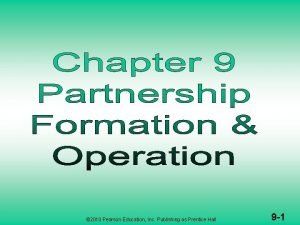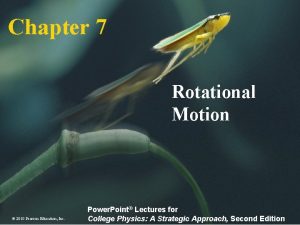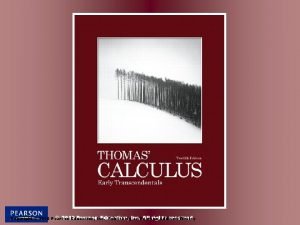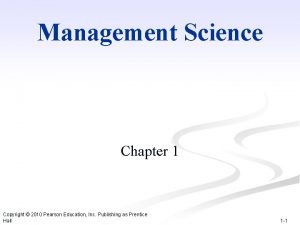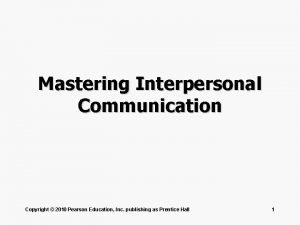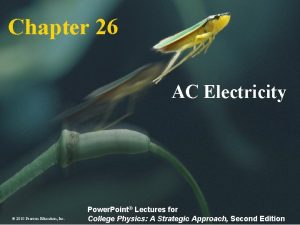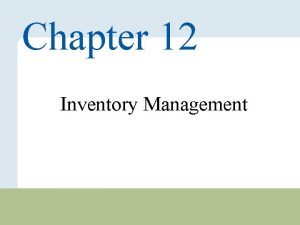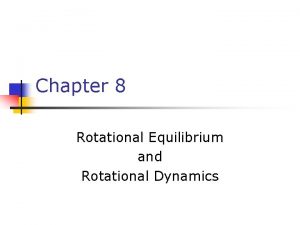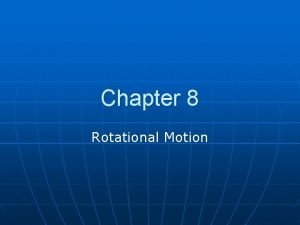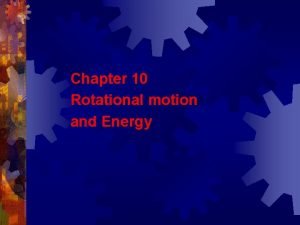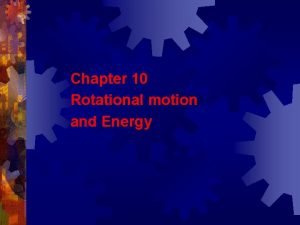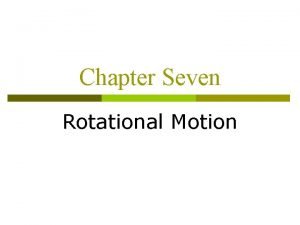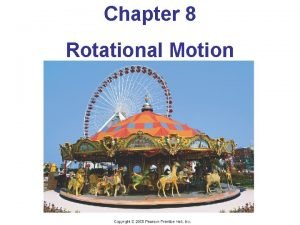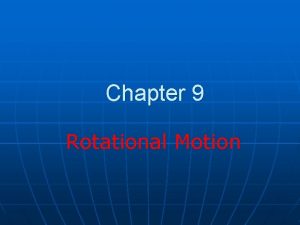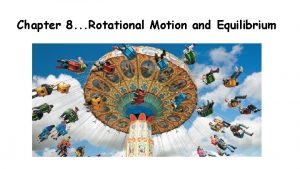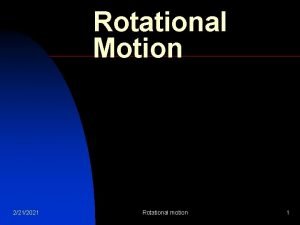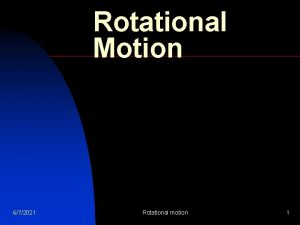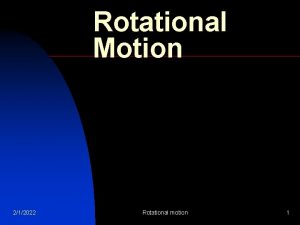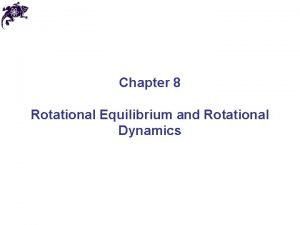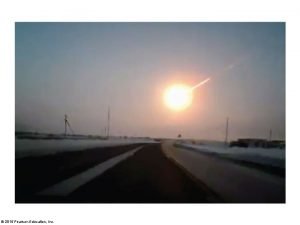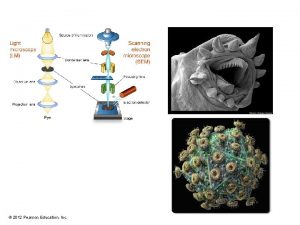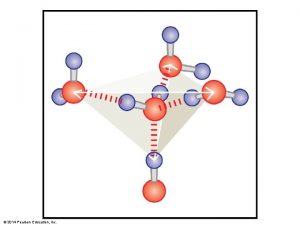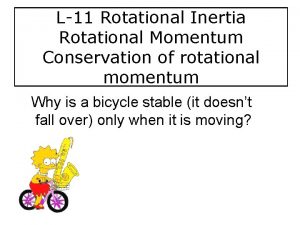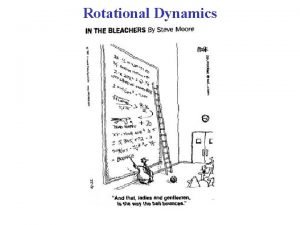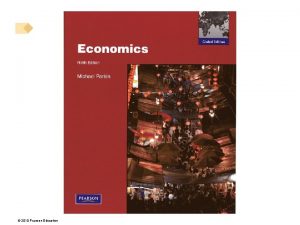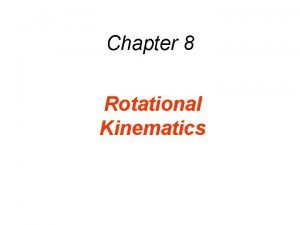Chapter 7 Rotational Motion 2010 Pearson Education Inc











































- Slides: 43

Chapter 7 Rotational Motion © 2010 Pearson Education, Inc. Power. Point® Lectures for College Physics: A Strategic Approach, Second Edition

7 Rotational Motion © 2010 Pearson Education, Inc. Slide 7 -2

© 2010 Pearson Education, Inc. Slide 7 -3

© 2010 Pearson Education, Inc. Slide 7 -4

Reading Quiz 1. Moment of inertia is A. B. C. D. the rotational equivalent of mass. the point at which all forces appear to act. the time at which inertia occurs. an alternative term for moment arm. © 2010 Pearson Education, Inc. Slide 7 -5

Answer 1. Moment of inertia is A. B. C. D. the rotational equivalent of mass. the point at which all forces appear to act. the time at which inertia occurs. an alternative term for moment arm. © 2010 Pearson Education, Inc. Slide 7 -6

Reading Quiz 2. Which factor does the torque on an object not depend on? A. B. C. D. The magnitude of the applied force. The object’s angular velocity. The angle at which the force is applied. The distance from the axis to the point at which the force is applied. © 2010 Pearson Education, Inc. Slide 7 -7

Answer 2. Which factor does the torque on an object not depend on? A. B. C. D. The magnitude of the applied force. The object’s angular velocity. The angle at which the force is applied. The distance from the axis to the point at which the force is applied. © 2010 Pearson Education, Inc. Slide 7 -8

Reading Quiz 3. Which statement about an object’s center of gravity is not true A. If an object is free to rotate about a pivot, the center of gravity will come to rest below the pivot. B. The center of gravity coincides with the geometric center of the object. C. The torque due to gravity can be calculated by considering the object’s weight as acting at the center of gravity. D. For objects small compared to the earth, the center of gravity and the center of mass are essentially the same. © 2010 Pearson Education, Inc. Slide 7 -9

Answer 3. Which statement about an object’s center of gravity is not true? A. If an object is free to rotate about a pivot, the center of gravity will come to rest below the pivot. B. The center of gravity coincides with the geometric center of the object. C. The torque due to gravity can be calculated by considering the object’s weight as acting at the center of gravity. D. For objects small compared to the earth, the center of gravity and the center of mass are essentially the same. © 2010 Pearson Education, Inc. Slide 7 -10

Reading Quiz 4. A net torque applied to an object causes A. B. C. D. a linear acceleration of the object to rotate at a constant rate. the angular velocity of the object to change. the moment of inertia of the object to change. © 2010 Pearson Education, Inc. Slide 7 -11

Answer 4. A net torque applied to an object causes A. B. C. D. a linear acceleration of the object to rotate at a constant rate. the angular velocity of the object to change. the moment of inertia of the object to change. © 2010 Pearson Education, Inc. Slide 7 -12

Checking Understanding Two coins rotate on a turntable. Coin B is twice as far from the axis as coin A. The angular velocity of A is twice that of B. B. The angular velocity of A equals that of B. C. The angular velocity of A is half that of B. © 2010 Pearson Education, Inc. Slide 7 -13

Answer Two coins rotate on a turntable. Coin B is twice as far from the axis as coin A. The angular velocity of A is twice that of B. B. The angular velocity of A equals that of B. C. The angular velocity of A is half that of B. All points on the turntable rotate through the same angle in the same time. All points have the same period. © 2010 Pearson Education, Inc. Slide 7 -14

Checking Understanding Two coins rotate on a turntable. Coin B is twice as far from the axis as coin A. The speed of A is twice that of B. B. The speed of A equals that of B. C. The speed of A is half that of B. © 2010 Pearson Education, Inc. Slide 7 -15

Answer Two coins rotate on a turntable. Coin B is twice as far from the axis as coin A. The speed of A is twice that of B. B. The speed of A equals that of B. C. The speed of A is half that of B. Twice the radius means twice the speed © 2010 Pearson Education, Inc. Slide 7 -16

Angular Acceleration Angular acceleration α measures how rapidly the angular velocity is changing: © 2010 Pearson Education, Inc. Slide 7 -17

Linear and Circular Motion Compared © 2010 Pearson Education, Inc. Slide 7 -18

Linear and Circular Kinematics Compared © 2010 Pearson Education, Inc. Slide 7 -19

Sign of the Angular Acceleration © 2010 Pearson Education, Inc. Slide 7 -20

Example Problem A high-speed drill rotating CCW takes 2. 5 s to speed up to 2400 rpm. A. What is the drill’s angular acceleration? B. How many revolutions does it make as it reaches top speed? © 2010 Pearson Education, Inc. Slide 7 -21

Centripetal and Tangential Acceleration © 2010 Pearson Education, Inc. Slide 7 -22

Checking Understanding The four forces shown have the same strength. Which force would be most effective in opening the door? A. B. C. D. E. Force F 1 Force F 2 Force F 3 Force F 4 Either F 1 or F 3 © 2010 Pearson Education, Inc. Slide 7 -23

Answer The four forces shown have the same strength. Which force would be most effective in opening the door? A. B. C. D. E. Force F 1 Force F 2 Force F 3 Force F 4 Either F 1 or F 3 © 2010 Pearson Education, Inc. Slide 7 -24

Interpreting Torque is due to the component of the force perpendicular to the radial line. © 2010 Pearson Education, Inc. Slide 7 -25

A Second Interpretation of Torque © 2010 Pearson Education, Inc. Slide 7 -26

Signs and Strengths of the Torque © 2010 Pearson Education, Inc. Slide 7 -27

Example Problem Revolutionaries attempt to pull down a statue of the Great Leader by pulling on a rope tied to the top of his head. The statue is 17 m tall, and they pull with a force of 4200 N at an angle of 65° to the horizontal. What is the torque they exert on the statue? If they are standing to the right of the statue, is the torque positive or negative? © 2010 Pearson Education, Inc. Slide 7 -28

Center of Gravity = © 2010 Pearson Education, Inc. Slide 7 -29

Calculating the Center-of-Gravity Position © 2010 Pearson Education, Inc. Slide 7 -30

Example Problem An object consists of the three balls shown, connected by massless rods. Find the x- and y-positions of the object’s center of gravity. © 2010 Pearson Education, Inc. Slide 7 -31

Checking Understanding Which point could be the center of gravity of this L-shaped piece? © 2010 Pearson Education, Inc. Slide 7 -32

Answer Which point could be the center of gravity of this L-shaped piece? (a) © 2010 Pearson Education, Inc. Slide 7 -33

Newton’s Second Law for Rotation I = moment of inertia. Objects with larger moments of inertia are harder to get rotating. © 2010 Pearson Education, Inc. Slide 7 -34

Moments of Inertia of Common Shapes © 2010 Pearson Education, Inc. Slide 7 -35

Rotational and Linear Dynamics Compared © 2010 Pearson Education, Inc. Slide 7 -36

© 2010 Pearson Education, Inc. Slide 7 -37

Example Problem The motor in a CD player exerts a torque of 7. 0 x 10 -4 N · m. What is the disk’s angular acceleration? (A CD has a diameter of 12. 0 cm and a mass of 16 g. ) © 2010 Pearson Education, Inc. Slide 7 -38

Constraints Due to Ropes and Pulleys © 2010 Pearson Education, Inc. Slide 7 -39

Example Problem How long does it take the small mass to fall 1. 0 m when released from rest? © 2010 Pearson Education, Inc. Slide 7 -40

Rolling Is a Combination of Translation and Rotation © 2010 Pearson Education, Inc. Slide 7 -41

Summary © 2010 Pearson Education, Inc. Slide 7 -42

Additional Example Problem A baseball bat has a mass of 0. 82 kg and is 0. 86 m long. It’s held vertically and then allowed to fall. What is the bat’s angular acceleration when it has reached 20° from the vertical? (Model the bat as a uniform cylinder). © 2010 Pearson Education, Inc. Slide 7 -43
 2010 pearson education inc
2010 pearson education inc Copyright 2010 pearson education inc
Copyright 2010 pearson education inc 2010 pearson education inc answers
2010 pearson education inc answers 2010 pearson education inc answers
2010 pearson education inc answers 2010 pearson education inc answers
2010 pearson education inc answers 2010 pearson education inc answers
2010 pearson education inc answers 2010 pearson education inc
2010 pearson education inc 2010 pearson education inc
2010 pearson education inc Copyright 2010 pearson education inc
Copyright 2010 pearson education inc 2010 pearson education inc
2010 pearson education inc Copyright 2010 pearson education inc
Copyright 2010 pearson education inc 2010 pearson education inc answers
2010 pearson education inc answers 2010 pearson education inc answers
2010 pearson education inc answers 2010 pearson education inc
2010 pearson education inc 2010 pearson education inc
2010 pearson education inc 2010 pearson education inc
2010 pearson education inc 2010 pearson education inc answers
2010 pearson education inc answers 2010 pearson education inc
2010 pearson education inc 2010 pearson education inc
2010 pearson education inc 2010 pearson education inc answers
2010 pearson education inc answers 2010 pearson education inc answers
2010 pearson education inc answers 2010 pearson education inc
2010 pearson education inc Copyright 2010 pearson education inc
Copyright 2010 pearson education inc Copyright 2010 pearson education inc
Copyright 2010 pearson education inc Copyright 2010 pearson education inc
Copyright 2010 pearson education inc Copyright 2010 pearson education inc
Copyright 2010 pearson education inc Copyright 2010 pearson education inc
Copyright 2010 pearson education inc Copyright 2010 pearson education inc
Copyright 2010 pearson education inc Copyright 2010 pearson education inc
Copyright 2010 pearson education inc Pearson education inc. all rights reserved
Pearson education inc. all rights reserved 2010 pearson education inc answers
2010 pearson education inc answers Income statement pearson
Income statement pearson Reorder point formula example
Reorder point formula example Pearson education inc. publishing as prentice hall
Pearson education inc. publishing as prentice hall Pearson education 2011
Pearson education 2011 2011 pearson education inc
2011 pearson education inc Pearson education inc publishing as pearson prentice hall
Pearson education inc publishing as pearson prentice hall Pearson 2012
Pearson 2012 2008 pearson prentice hall inc
2008 pearson prentice hall inc Rotational equilibrium and rotational dynamics
Rotational equilibrium and rotational dynamics Rotational equilibrium and rotational dynamics
Rotational equilibrium and rotational dynamics 2018 pearson education inc
2018 pearson education inc Pearson education limited 2017
Pearson education limited 2017 Copyright by pearson education inc. answers
Copyright by pearson education inc. answers



